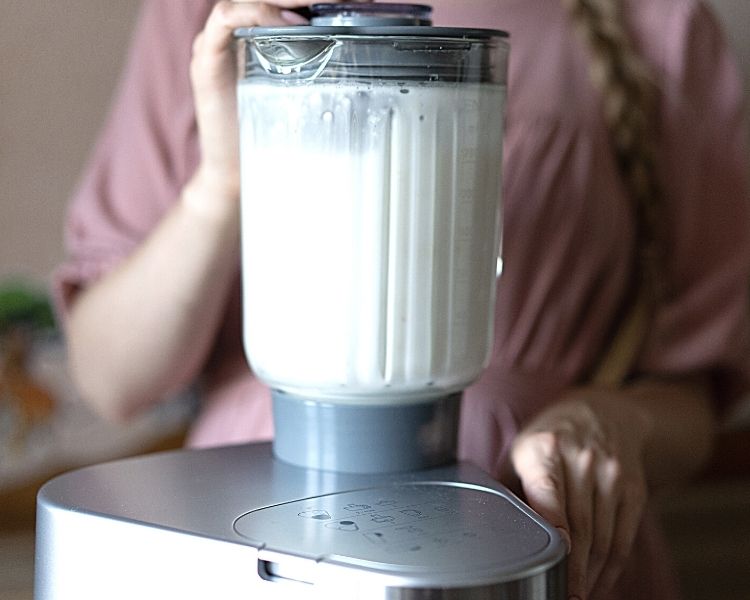The process of homogenizing milk is standard in the food industry. Typically, when regular milk sits for a while, a layer of fat forms at the top. But when you homogenize the milk, you break down these fat particles to disperse evenly through the milk.
Homogenized milk has a longer shelf life. Moreover, milk from different cows ends up tasting the same. That is how the milk companies get to sell milk from thousands of cows.
Ever considered making homogenized milk at home? This brings us to the next question: Can you use a blender instead of a homogenizer for milk?
Here's the thing; it may not be ideal, but you can use a blender to homogenize milk at home.
How Does a Blender Work?

Long before people started using industrial machines to homogenize milk, they would shake up containers with milk to achieve a certain consistency. The idea behind the homogenization process is to create turbulence that’s strong enough to break down the fat globules in the milk into miniscule portions.
Shaking would do that, but only to a certain degree. Now, when you use a blender, you add more power to the turbulence, making it easier for the fat particles to disperse evenly through the milk. The faster the rotation of the blender’s blades, the more turbulence and the better the result of your homogenization.
Theories Around Homogenization
Many theories of homogenization exist. Globule disruption by turbulent eddies also referred to as micro whirls, is one of the prominent theories. This theory bases its argument on the grounds that a vast number of small eddies develop when a liquid is traveling at high velocities. The higher the velocity of the fluid, the smaller the whirls. When these eddies cross paths with an oil or fat molecule in the milk, it breaks it up.
Another theory is the cavitation theory. This claim suggests that when a stream of bubbles implodes in a liquid, the shock waves are created to disrupt the fat globules, breaking them into smaller parts.
How Blender can Work as a Milk Homogenizer?
Unlike an industrial or lab-grade milk homogenizer that pushes the milk through tiny holes at high pressure, a blender works by shearing. Shearing is a process through which a blender causes particles to break off due to tangential force applied to the sample.
The rotation of the blades on the blender transfers a shock wave into the liquid, while the rotation causes turbulent eddies. The motion and waves created by the blades cause the fat droplets in the milk to break down, thereby dispersing evenly in the liquid.
A blender is relatively easy to use compared to an industrial milk homogenizer. You will need to place your whole milk in the jug and blend it.
The blender blades will cut the fat molecules in the milk into smaller pieces, making it possible to mix evenly throughout the product.
Furthermore, the blade-type homogenizers, also known as blenders, can produce fine extracts from plants and animal tissues. The bottom or top-driven blade cuts the product at speeds of 6,000-50,000 rpm, resulting in a consistent result.
How to Homogenize Milk Using a Blender?
Although milk homogenization is a complicated process, you can attempt to replicate the results at home. Of course, the results might not be as perfect as commercially available milk, but you get fair results.
Before you can use your blender to break down the fat particles into smaller sizes, there are a few initial steps you should take.
The DIY process of homogenizing milk includes:
Turn on the blender and continue with the process until you have your desired consistency.
Can’t decide which blender to buy? Here’s some help:
Countertop Blenders
- PROFESSIONAL POWER: 1000 watts of professional power can crush ice and breakdown any tough ingredient.Power source : Corded Electric.Amperage : 12.5 amps
- XL CAPACITY: The 72 oz professional blender pitcher is excellent for making frozen drinks and creamy smoothies for the entire family. 64 oz. max liquid capacity
- INTELLIGENT TECHNOLOGY: Total Crushing Technology delivers unbeatable power with blades that pulverize and crush through ice, whole fruits and vegetables in seconds.
- ICE CRUSHING: Blast ice into snow in seconds and blend your favorite ingredients into delicious resort-style frozen drinks
- RECIPE INSPIRATION: The included recipe guide provides drink and dish making inspiration.
- POWERFUL: 1200-Watt motor
- PRE-PROGRAMMED: Pulse cycle with automatic shut-off
- Pulverizing
- High torque power base
- Hands-free auto-off for optimal extraction
- Variable Speed Control: Ten variable speeds allow you to refine every texture with culinary precision, from the smoothest purées to the heartiest soups
- Pulse Feature: Layer coarse chops over smooth purées for heartier recipes, such as chunky salsas or thick vegetable soups.
- The 48-ounce container is ideal for blending medium batches for small family meals. Cutting blades measuring 3-inch diameter to ensure a consistent blend every time. Electrical Ratings-120 V
- Hardened Stainless-Steel Blades: Our aircraft-grade stainless steel blades are designed to handle the toughest ingredients, so from the first blend to the last, you get the same quality results. Cord length: 4.5 feet
- Self-Cleaning: With a drop of dish soap and warm water, your Vitamix machine can clean itself in 30 to 60 seconds. What's in the Box: motor base, 48 oz. container, mini-tamper, cookbook
Hand Blenders
- No More Lumpy Chunks – Mix, blend, whisk, and froth quickly with our slim yet powerful immersion blender. Includes detachable accessories to make smoothies, whipped cream, even beaten eggs.
- 3 Easy Attachments – Stick blender with: (1) Stainless Steel Blending Shaft to blend shakes, soup, baby food; (2) Frother for foaming all milk types; (3) Whisk for whipping cream or batter.
- Turbo Power – Increase power with Turbo Mode on this handheld blender with its ergonomic grip and non-slip handle. The blade housing reduces splashes.
- Simple Steps – Add an attachment, plug it in, submerge the blade, then blend, and adjust the speed. See included instructions for details.
- Easy Maintenance – Cleaning up is simple! Blending Shaft, Whisk, and Frother are dishwasher safe. Made in China.
- CORDLESS FREEDOM: Move freely around your busy kitchen with this rechargeable hand blender/mixer. Get up to 20 minutes of cord-free blending power from each charge.
- COMPACT & POWERFUL: Powerful speeds of up to 15,000 RPM means you’ll get the job done quickly and efficiently. This small blender and stainless-steel blade provide plenty of power for all your culinary needs.
- VARIABLE SPEEDS: Whether you need to blend ice for your margarita, or your soup needs a swirl, you set the ideal speed with one touch button for variable speed control. Reduces suction and splashing.
- SINGLE SERVINGS: With a regular-sized blender, you often get more than you need. If you want just enough for one, this single blender for shakes and smoothies is the perfect solution for sized-right servings.
- CHARGE INDICATORS: The colorful LED light ring illuminates three different colors to notify you when fully charged, getting low, and when it’s time to plug in, so you aren’t left without power mid-blend. Once fully charged, it can hold a charge for up to a year before use.
- UNMATCHED POWER – From our Titanium steel 4 blade rotation system, to our full copper 800 watt clump destroying motor, no other stick blender matches this model's ability to crush, pulverize, and smoothly blend, so any recipe or smoothie can be made with the easiest cleanup.
- PRECISE CONTROL - 12-speeds give you maximum choice and precision to prepare salsas, shakes, smoothies, baby food, and more! 800 Watts of power drives consistently smooth results and high performance. Use the TURBO boost for maximum speed and a more homogeneous mixture.
- MULTI-FUNCTIONAL MASTERY - Beyond blending, our comprehensive set includes a Snap-on Whisk attachment, Beaker (20 fl. oz) and Twist and Lock Chopper (16oz) with removable blade, redefining the 3-in-1 kitchen appliance concept. The chopper acts as your mini food processor with the perfect lid to eliminate mess and tearing eyes when chopping white or red onions!
- CONVENIENCE AT ITS BEST - The hand mixer is designed with a comfy grip handle for a non-slip, comfortable hold, and a sleek body that fits into mixing bowls and pots of all sizes. Simplify your cleaning process with our easy-to-detach, dishwasher-safe parts, and enjoy the stability of a non-slip base during use.
- LIVE CUSTOMER CARE – Talk to us via our toll-free number or live chat, not via email like our competitors. Mueller believes in making life easier, better and more enjoyable in all that we do. Our total satisfaction promise covers all our products. If you need any help, please feel free to contact us.
Pros and Cons of Using a Blender as a Homogenizer
Pros
Cons
Verdict
The milk homogenization process is an intense and complicated procedure. It requires industrial-grade equipment to work seamlessly. If you can avoid the hassle of trying to homogenize your milk at home, it would be for the best. Despite that, if you would like to homogenize milk at home, your blender is an alternative tool at your disposal.
Sources:






